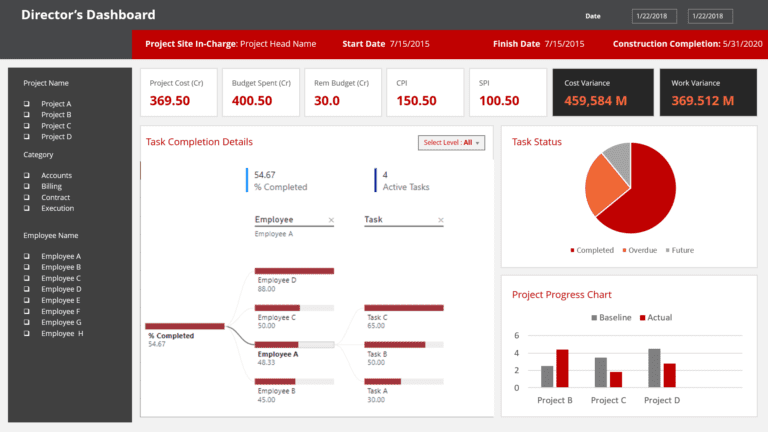
The current state of the global engineering, procurement, and construction (EPC) industry canbe accurately described as quite “challenging.” From complex contracting models that discourage collaboration to unpredictable commodity prices that undermine the attractiveness of the sector as an employer, the reasons are many and way more complex.
As the EPC and construction industries are changing rapidly, so is their need for Business Intelligence (BI) and analytics.This brings up a great question; How construction & EPC companies gain value from BI?
Many contracting firms already know they need a BI solution. The ambiguous meaning still leaves them wondering exactly where to shift their focus. Big vendors like Microsoft, Tableau, and QlikView provide great BI solutions and visual representation of the data. But a more precise way for construction and EPC companies to look at business intelligence should be in terms of a defining “strategy” – “What’s your BI strategy and how can you gain value out of it?” I would certainly like to warn the contractors not to implement a BI solution without having a clear strategy and roadmap in mind.
As a standard best practice, it is advised not to invest in a BI solution only for the sake of producing better reports. This might not be fruitful in the long term and may not see a full return on investment.
Let us take a scenario here. The CEO of a construction company hears about a great Project Management solution to simplify many processes and get useful insights out of their data. He decided to take this project and calls a meeting with the executives and managers to tell them about this innovation.
Of course, there was excitement initially for this throughout the company, but eventually, it became short-lived. The field stopped using the system, PMs are still using spreadsheets, and a few months later, the whole solution and BI reports are a candle in the wind. You will experience your money wasted if BI adoption is not done right.
One of the ideal ways to approach this is to look for low-hanging fruits first, which gives the opportunity to setup a base and let the field and other team members slowly get introduced to the new system and then eventually trying to fit it in the system.
Taking advantage of self-service BI and modern analytics
Nowadays, while engineering and construction companies understand the value they can gain through BI and advanced data analytics, less than half of them have a bullet proof plan in place to build what they need.
Let’s take another case; a major EPC company experienced substantial variances between how divisions and regions staffed major capital construction projects, impacting overall cost and schedule performance.
The company knew they were in dire straits,and to dodge this bullet, the firm built a robust road map that they could easily follow, used their data better, and transform this data into insights. So, they sought insights and opportunities from their data to improve project performance and reduce costs by optimizing global staffing based on data from past projects.
They leveraged their historic data and assessed it to gain a transparent picture of the available information to gather key attributes like average staffing, staffing by groups, by regions, etc.
They started by establishing their KPIs (Key Performance Indicators) and objectives for analyzing resources models and staffing of completed projects to determine if sufficient resources are in the right roles to reduce risk, control cost, and ensure quality.
Using the right set of BI tools, they performed a detailed analysis of staffing levels across the population of projects.
As a result of this solution, they established KPIs and benchmarks to assess staffing levels for all their future projects.
They could get the right data, develop a predictive model for anticipating the number of project employees required by different categories and start taking actions based on the gained insights.
EPC companies have too many irons in the fire,and with so many processes, they are left with little or no space for guesswork anymore. It is important that the data is rightly used, is reliable, and optimized to ensure high-quality deliveries, and BI certainly can help with that.
Delays, cost overruns, disparate data, and untapped potential in productivity all lead to multiple challenges that ultimately generate huge costs and decrease productivity.
How EPC companies can upscale their project management with BI adoption
Possibly for most of the successful EPC and construction companies, one of the most important drivers for adopting business intelligence tools is the increasing demand by building owners and clients for insightful databased on which they can take action. Constructing, designing, and operating a building is a costly venture. When any type of new investment is being made, owners and clients want to ensure that they have sufficient data to support decision-making in the near- and long term.

By introducing self-service reporting, real-time dashboards,and detailed project reports, the project leaders, architects, managers, and the whole management can gain a clear overview of where they stand and can track critical metrics and milestones easily, thus resolving countless administrative hours and eventually increasing productivity levels.
It goes without saying that BI and predictive analytics brings great value in the EPC and construction industry since it enables in streamlining the processes and data and enhance the possibility to utilize modern solutions such as machine learning, forecasting, and advanced reporting to foresee future project scenarios.
Summing up
The sole purpose of using business intelligence in the construction industry is to focus on process automation, predictive analytics, or building dashboards and derive insights that will transform the companies into a more sustainable one and build strength at the core and create a focal point for generating growth.
There’s no one-size-fits-all approach to adopting BI into place for EPC firms. However, setting up the right roadmap, defining business goals, key objectives for data analysis, and planning how the organization will use the results can help them setup a foundation to improve all the processes and identify problems before they occur.



